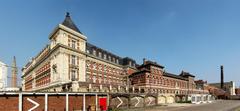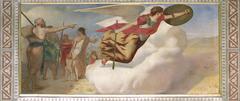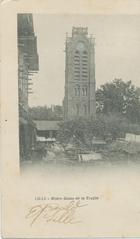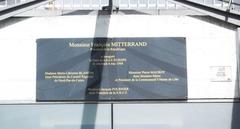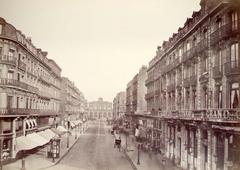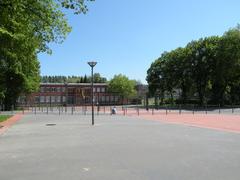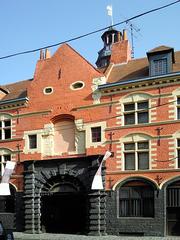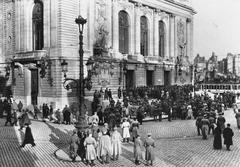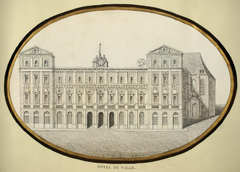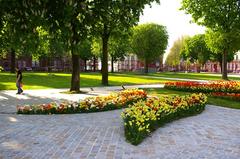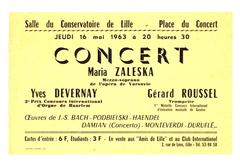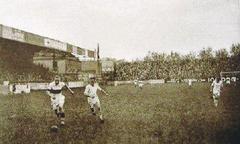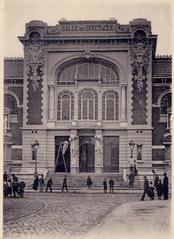Canteleu Lille France: Visiting Hours, Tickets, and Historical Sites Guide
Date: 04/07/2025
Introduction
Located in the vibrant northern French city of Lille, the neighborhood of Canteleu offers visitors a unique opportunity to explore the region’s layered history, innovative spirit, and cultural dynamism. From its medieval origins and industrial transformations to its present-day role as a hub for technology and green living, Canteleu stands as a testament to Lille’s adaptability and charm. This comprehensive guide provides detailed information on Canteleu’s historical significance, must-see landmarks, practical visiting tips—including opening hours and ticketing—and highlights nearby attractions to help you make the most of your Lille adventure (Nomads Travel Guide; Becoming Carmen).
Table of Contents
- Introduction
- Historical Overview of Lille and Canteleu
- Canteleu: Origins, Landmarks, and Urban Evolution
- Visiting Canteleu and Lille: Hours, Tickets, and Accessibility
- Nearby Attractions
- Frequently Asked Questions (FAQ)
- Conclusion and Travel Tips
- Useful Links
- References
Historical Overview of Lille and Canteleu
Lille’s Early History and Growth
Lille’s roots reach back to Roman times, where its strategic location along the Deûle River fostered settlement and trade. Over centuries, the city blossomed under Flemish rule, becoming a major commercial and textile center in the Middle Ages (Nomads Travel Guide). The city’s architecture and winding streets in Vieux Lille (Old Lille) still reflect this era’s prosperity (Becoming Carmen).
Political Changes and Industrial Expansion
Lille’s fortunes shifted between Spanish and French rule in the 16th and 17th centuries, with King Louis XIV commissioning the iconic star-shaped Vauban Citadel after the city’s annexation to France in 1668. The 19th century ushered in rapid industrialization, prompting urban growth and the integration of neighboring hamlets like Esquermes—home to Canteleu—into the city’s expanding fabric (Becoming Carmen).
Canteleu: Origins, Landmarks, and Urban Evolution
Etymology and Early Development
The name “Canteleu” is derived from the Picard phrase “cante leu” or “sing wolf.” Historically a hamlet within Esquermes, Canteleu was annexed by Lille in 1858. The area developed around Rue de Canteleu—one of the oldest streets in the Vauban-Esquermes district—dating back to the 12th century (Good Morning Lille).
Architectural and Cultural Highlights
- Rue de Canteleu: Once divided by the 19th-century Porte de Canteleu gate, this residential street now stretches about 800 meters and remains lined with historic houses.
- Chapelle Notre-Dame-de-Réconciliation: Still active today, this chapel offers insight into the area’s spiritual heritage.
- Maison Cardon: A notable business at 66 Rue de Canteleu, recognized for its longstanding roofing craftsmanship since 1875.
- Historic Worker Housing: Built from 1866, these residences reflect Canteleu’s social history and industrial past.
- Euratechnologies Campus: A striking example of urban renewal, this restored textile factory now serves as a major European tech and startup hub, often hosting public events and exhibitions (Euratechnologies Official Website).
Social and Medical History
In the 17th century, Canteleu housed the “Maison de santé du riez de Canteleu,” an isolation hospital for plague victims that remained in use until 1791 (Good Morning Lille). Despite proposals for independence, Canteleu has remained a vital part of Lille’s urban landscape.
Visiting Canteleu and Lille: Hours, Tickets, and Accessibility
Key Landmarks: Opening Hours & Entry
- Vauban Citadel: Open daily, generally from 9 AM to 6 PM. Free entry; guided tours may require a small fee and advance booking.
- Chapelle Notre-Dame-de-Réconciliation: Open during daylight hours; free access.
- Euratechnologies Campus: Open to visitors mainly on weekdays from 9:00 AM to 6:00 PM. Some events may require advance registration (Euratechnologies Official Website).
Getting There and Around
- Metro: Canteleu-Euratechnologies station (Line 2) is fully accessible and ideal for reaching the district.
- Bus and Tram: Multiple lines connect Canteleu with Lille city center and surrounding neighborhoods (Nomads Travel Guide).
- Cycling: V’Lille bike-sharing stations and dedicated canal-side bike paths make cycling a convenient option (V’Lille Bike Sharing System).
- On Foot: The area is pedestrian-friendly, with scenic routes along the Deûle Canal and through local parks.
Accessibility
Most major sites and public transport stations provide step-free access and facilities for visitors with reduced mobility. Note that some older streets in Canteleu and Vieux Lille are cobbled and may be uneven.
Guided Tours and Events
Guided walking tours are available, focusing on Lille’s Old Town, Vauban district, and Canteleu’s highlights. Seasonal events, tech fairs at Euratechnologies, and the famous Lille Braderie flea market enhance the visitor experience.
COVID-19 Updates
Please refer to local health guidelines and check official websites for the latest updates on opening hours and access to indoor sites.
Nearby Attractions
- Parc de la Citadelle: A vast green space ideal for relaxation, picnics, and outdoor activities.
- Vieux Lille: Historic center with cobbled streets, baroque facades, shops, and cafés.
- Lille Grand Place: The city’s central square, renowned for markets and cultural events.
Frequently Asked Questions (FAQ)
Q: What are the visiting hours for the Vauban Citadel?
A: Open daily from 9 AM to 6 PM; hours may change seasonally.
Q: Are there entrance fees for major landmarks?
A: Most sites, like the Chapelle Notre-Dame-de-Réconciliation, are free. Some guided tours or exhibitions may have a fee.
Q: How do I reach Canteleu from Lille’s city center?
A: By Metro Line 2 (Canteleu-Euratechnologies station), bus, or a 15-minute walk.
Q: Is Canteleu suitable for visitors with reduced mobility?
A: Most main sites and transport are accessible, though cobblestones may pose challenges in some areas.
Q: When is the best time to visit?
A: Spring and early autumn for pleasant weather and fewer crowds.
Conclusion and Travel Tips
Canteleu offers an authentic and peaceful window into Lille’s past and present. From medieval streets and chapels to innovative tech centers and canal-side walks, it’s an ideal destination for history lovers, tech enthusiasts, and families alike. Take advantage of Lille’s excellent public transport, plan your route with the Audiala app, and consider joining guided tours for deeper insights.
For the latest travel tips, event updates, and personalized recommendations, download the Audiala app and follow us on social media. Make Lille and Canteleu a memorable part of your French journey—where history, culture, and innovation come together.
Useful Links
- Euratechnologies Official Website
- Lille Public Transport Info
- V’Lille Bike Sharing System
- Lille Tourism Office
References
- This guide draws on information from Nomads Travel Guide, Becoming Carmen, Good Morning Lille, Euratechnologies Official Website, and the Official Lille Tourism Website.
